Guest post by Josh Hillis, author of Lean And Strong
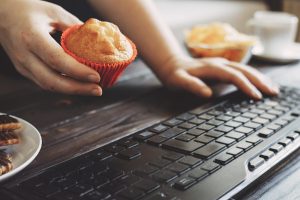 Mostly, when people talk about nutrition, they talk about the things that they planned to eat. They talk about macros or portion sizes or adding vegetables. Mostly, people talk about what to eat when you’re sitting down to a meal.
Mostly, when people talk about nutrition, they talk about the things that they planned to eat. They talk about macros or portion sizes or adding vegetables. Mostly, people talk about what to eat when you’re sitting down to a meal.
On the flip-side, the biggest issue that most people have with their nutrition is snacking between meals. Snacks tend to be lower quality, less filling per calorie, and often entirely unreleated to hunger.
Many a person has felt like they “blew their diet” because they they ate a snack in the middle of the afternoon that was tiredness, procrastination, or stress. Or maybe they walked by the muffins in the breakroom, and they just looked really good. It’s these habitual or mindless snacks that are really what are getting in the way of people’s goals.
There aren’t any special diets or rules that are going to fix that non-hunger eating that comes up. You have to practice eating skills and guidelines that allow you to get to the root of the issue.
In the moment, these always “feel like hunger,” even if they aren’t. In this post, you’re going to learn how to sort out the difference.
Note: None of this applies to people who are eating healthy snacks deliberately and who adjust their meal sizes accordingly. Research indicates that the great majority of people snack mindlessly, and that it has no impact on how much they eat at meals.
So, if you are eating 5-6 times per day, and all of those are planned, that’s totally fine. On the other hand, if you’re having 2 or 3 meals on purpose, and other snacks just kind of show up, that’s something to work on.
Planned Snacks Unplanned Snacks
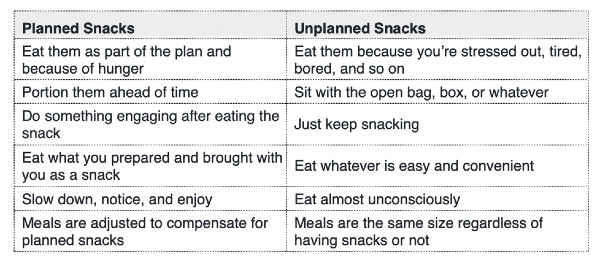
Whatever your goals are around nutrition, you’re going to be more effective if you’re more mindful and more aware of why you’re snacking and what you’re using food for.
If you don’t feel like you’re in the driver’s seat with snacking, you just need some guidelines and skills to put you there.
Two Eating Guidelines, One Eating Skill
We’re going to create a framework with two guidelines, and then we’re going to put in a skill to help you figure out what’s going on:
1. Guideline: 4-6 hours between meals, without snacking
2. Guideline: Pausing 10 minutes before having a snack
3. Skill: Distinguishing hunger from stress, boredom, procrastination, tiredness and everything else
It’s important to note that the guidelines are just guidelines — they aren’t rules. We’ll dig in on that a little more as we go.
Guideline: 4-6 Hours Between Meals, Without Snacking
This is a basic framework for letting you know when to check in with yourself. 4-6 hours works really well for people who are doing 3 or 4 meals per day. Basically, if you’re eating 3 meals, or 3 meals and one snack around a workout, then 4-6 hours is pretty reasonable.
The idea here is really simple — if you had a balanced meal for lunch, and you’re “hungry” for a snack two hours later, that’s a red-flag that you need to check in with yourself.
If you’re someone who is planning to eat 5 times per day, that’s fine. You’d shorten the number of hours in the guideline to what works for your plan, maybe 3 hours. Conversely, some folks might really like to eat 2 times per day, and that’s fine too. They would extend their guideline. The point is simply to have a guideline to look at, if you get hungry between your planned meals.
Lastly, it’s not a rule. You actually can eat if it turns out you’re actually hungry. The point of the guideline is to let you know that you should check in.
Skill: Distinguish Hunger from Stress, Emotions, Procrastination, Tiredness, and everything else
So, what happens if you feel “hungry” during that 4-6 hour window? You check in with yourself!
Distinguishing hunger from everything else can be as simple as asking yourself three questions:
1. Do I feel a hollow feeling in my stomach?
2. Am I hungry for a balanced meal?
3. Does the hunger continue to build over time?
Hunger is a hollow feeling in your stomach. It sounds silly to say, but most of us have had so many years (decades) of not really paying attention, that we don’t actually know! Then, we get in the habit of eating for other reasons.
Sometimes we eat to mask stress or emotions. Other times we eat because we mistake other physical sensations for hunger, that actually are tiredness or thirst. Lastly, many folks have come to eat whenever they need a break at work, or when they’re procrastinating doing something hard. All of those things can feel like “hunger” if we don’t check in, and see if we actually feel a hollow feeling in our stomachs.
If you’re hungry, you’re going to be hungry for a balanced meal. A really simple red-flag is if you’re only “hungry” for the candy bar or the muffin in the break room. If it’s only a craving for a treat, you know it’s not hunger. It might be that those things are delicious (they are) or that you just walked by them (they’re in such pretty packaging). It’s totally normal to want delicious things when you see them. Also, this is another indicator that it might be tiredness or stress or something else — we crave high calorie, easy food, when we’re stressed and tired.
Lastly, hunger builds over time. Cravings often build for 10-20 minutes, then fade. If you have a craving, and just sit with it, much of the time it passes on it’s own. Hunger, on the other hand, will continue to build over that time. If your hunger for a balanced meal has intensified over time, that’s really hunger.
So, if you answer “yes” to 2 or 3 of those questions, then go have a balanced meal! If you get mostly “nos,” you know it’s probably just a craving.
Guideline: Pause 10 Minutes Before Snacking
As alluded to in the last skill — there’s a value in waiting. Cravings often fade over time.
It’s more powerful than that though. One of the reasons that we’ve come to associate so many non-hunger issues with snacking is just habit. If we feel tired and have a snack, it becomes a habit. If we feel stressed and we have a snack, it becomes a habit. If we see the snack food and eat it, it becomes a habit.
The problem isn’t the snack itself, the problem is that we have it automatically.
By simply pausing before having the snack, we start to loosen up that habit. We build strength in our ability to put some time between a wanting and an eating, and that’s a valuable skill all by itself.
Lastly, if we wait ten minutes, that gives us time to run through the above questions. It gives us time to sort out if it’s hunger or not.
If it’s not hunger, we can check in and find out what’s going on. We can look at the context — did my boss just yell at me? Am I procrastinating? We can look at our meals — did I eat enough at lunch? We can check in with our feelings — Am I sad? Stressed? We can check in with our physical state — did I get enough sleep last night?
We can go deeper, and check in with our values — do I want to be someone who manages stress with food? Or that if it’s ok to just want it — do I want to have this chocolate chip cookie, because I haven’t had one in a week or two, and I really love chocolate chip cookies? You get to choose.
That ten-minute pause smashes the habit of going from wanting to eating. It also gives us time to check in with ourselves. If it’s hard for you to check in with yourself, you could even extend the pause to 20 minutes. As you get really good at checking in with yourself, you can reduce the pause to 1 minute.
Conclusion
Now you have two guidelines for knowing when to check in, and giving yourself time to check in. You have a skill for checking in and figuring out if what you are feeling is hunger, or something else.
If you figure out that it’s something else, the trick is to realize that food doesn’t fix non-hunger issues. If you’re eating because you’re exhausted late at night, the answer is to go to sleep. If you’r eating because you’re stressed out, food doesn’t fix that for more than a couple of minutes, you need to find other ways to cope. If you are eating a snack because it’s the only time you give yourself a break at work, you’re need to give yourself a break that doesn’t involve food.
It’s too easy for snacking to become a catch all for everything in our lives that’s uncomfortable. A big part is learning that it’s ok to be uncomfortable, and it’s ok to feel all of your feelings. Despite what social media tells you, you don’t have to be happy and positive every minute of the day. You can be sad, or stressed out sometimes. And when you are, you don’t need to fix it with food.
The biggest benefit of learning to manage snacks by checking in with yourself, is that it’s a really robust practice. If you are always trying to white knuckle diet rules, you’ll always want to rebel against them, eventually. The goal is to have your food choices come from you. If it comes from checking in with yourself, you’ll feel good about doing it. It isn’t an external rule, it’s actually you honoring yourself.
Give yourself time and practice. If checking in with yourself like this is new to you, you’ll need a lot of reps to get good at it. It can be uncomfortable and awkward. But it’ll be worth it. Snacking won’t have the same hold over you or the same allure, because you’ll be able to check in with your own body and know what’s going on. After a few months, you’ll feel like you are in the driver’s seat with your eating. Having that autonomy around food is healthy, it feels good, and it’s really effective for hitting your goals.
-Josh Hillis
About The Author
 Josh Hillis helps people learn eating skills, beat emotional eating, and get the body composition results they want. He has appeared in The Denver Post, Strength Matters magazine, Experience Life magazine, the Los Angeles Times and USA Today. Josh is working on this thesis on the relationship between emotional eating and psychological flexibility. he is also the creator of the GMB Fitness Eating Skills program, and the author of the Book Lean and Strong. To visit Josh online, go to: www.JoshHillis.com. To read the summary / review of his new book, Lean and Strong, CLICK HERE
Josh Hillis helps people learn eating skills, beat emotional eating, and get the body composition results they want. He has appeared in The Denver Post, Strength Matters magazine, Experience Life magazine, the Los Angeles Times and USA Today. Josh is working on this thesis on the relationship between emotional eating and psychological flexibility. he is also the creator of the GMB Fitness Eating Skills program, and the author of the Book Lean and Strong. To visit Josh online, go to: www.JoshHillis.com. To read the summary / review of his new book, Lean and Strong, CLICK HERE


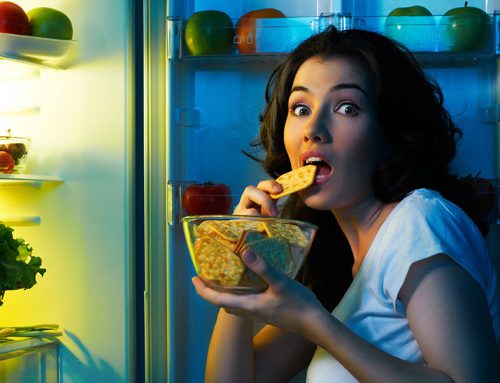
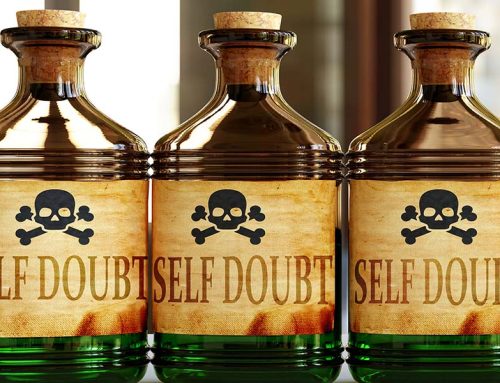
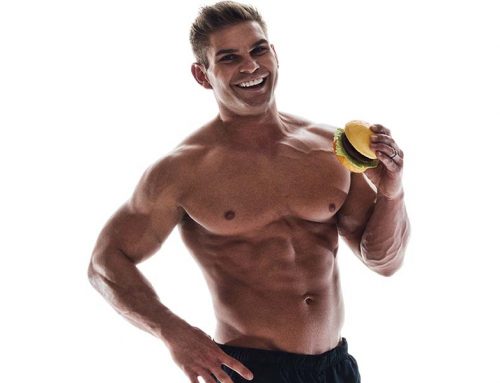
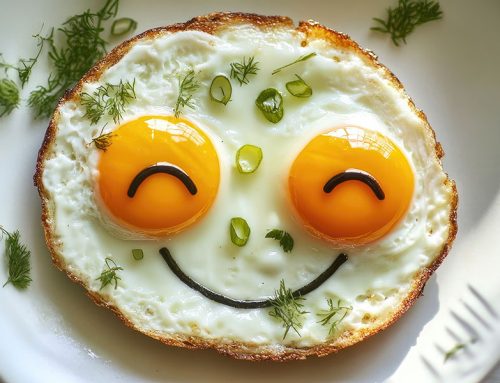
Wonderful article, I look forward to reading more of your material. This is some advice that I have found to be so incredibly true: “If you are always trying to white knuckle diet rules, you’ll always want to rebel against them, eventually.” The more I adequately feed my actual hunger cues the easier it is to not eat when I’m not actually hungry. Thanks for sharing!
A trick I use is to drink a full glass of water and then wait 10 minutes. If I don’t feel hungry anymore, it means I was actually thirsty, but (like you said) our bodies aren’t used to telling us what they need.